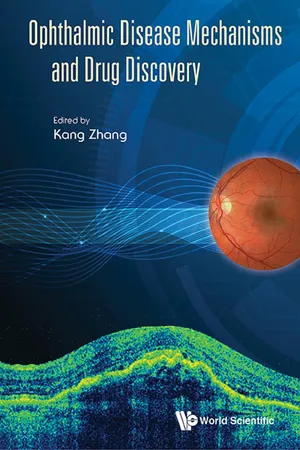Biological Sciences
Defects of the Eye
Defects of the eye refer to any abnormalities or impairments in the structure or function of the eye that affect vision. These can include refractive errors such as myopia, hyperopia, and astigmatism, as well as more serious conditions such as cataracts, glaucoma, and macular degeneration. Treatment options vary depending on the specific defect and may include corrective lenses, surgery, or medication.
Written by Perlego with AI-assistance
Related key terms
1 Key excerpts on "Defects of the Eye"
- eBook - ePub
- Kang Zhang(Author)
- 2016(Publication Date)
- WSPC(Publisher)
Chapter 1: Pathology and Mechanism of Eye DiseasesKatherine J. Wert † , Heike Kroeger ‡ , Frances Wu ‡ ,Stephen H. Tsang § , and Jonathan H. Lin‡ ,**† The Whitehead Institute for Biomedical Research,Cambridge, MA 02142‡ Departments of Pathology and Ophthalmology,University of California San Diego, La Jolla, CA 92093§ Departments of Ophthalmology, Pathology, and Cell Biology,Columbia University College of Physicians and Surgeons,New York, NY 10032** VA San Diego Healthcare System, San Diego, CA 921611.Introduction
Retinal degenerative diseases are the leading cause of irreversible blindness in Western nations, and the loss of sight affects over 3.4 million people in the United States alone.1 These diseases have high genetic and allelic heterogeneity, and therefore our understanding of the pathophysiology of these conditions is limited. However, progress in molecular genetics has determined specific factors that play significant roles in the pathogenesis of retinal degeneration. This chapter is focused on understanding the pathology of the human eye, the molecular genetics identified in degenerative diseases of the eye, and the current known mechanisms for these diseases.2.The Eye
The human eye is a complex organ that consists of many different cell types. The eye transmits information to be processed by the brain on the color, form, and light intensity of objects. The human eye can be divided into two main parts: the anterior and the posterior segments.22.1.Anterior eyeIn the anterior portion, the sclera and cornea act as outer protective layers of the eye. Also anterior in the eye is the uveal tract, composed of the iris, ciliary body, and anterior choroid. The components of the uveal tract mainly function under the control of the autonomic nervous system. The uveal tract allows for the exchange of nutrition and gases into the posterior portion of the eye. The ciliary body and the iris are directly supplied by the uveal vessels, while these vessels indirectly support the sclera, lens, and outer retina via diffusible nutrients. The uveal tract contains numerous melanocytes that reduce the light reflected within the eye and absorb light transmitted through the sclera, in order to improve the retinal image.2
Learn about this page
Index pages curate the most relevant extracts from our library of academic textbooks. They’ve been created using an in-house natural language model (NLM), each adding context and meaning to key research topics.
